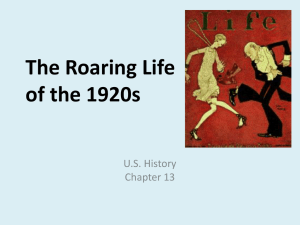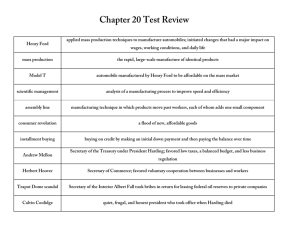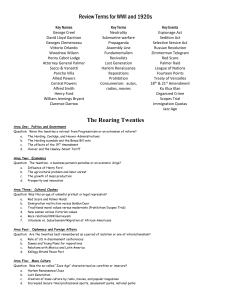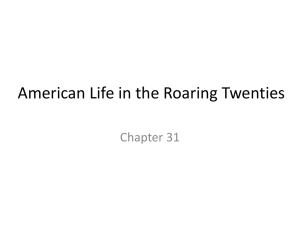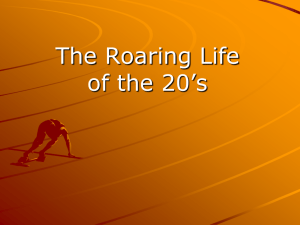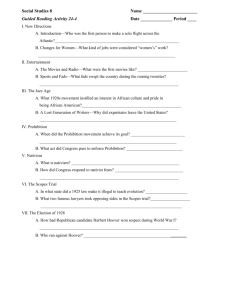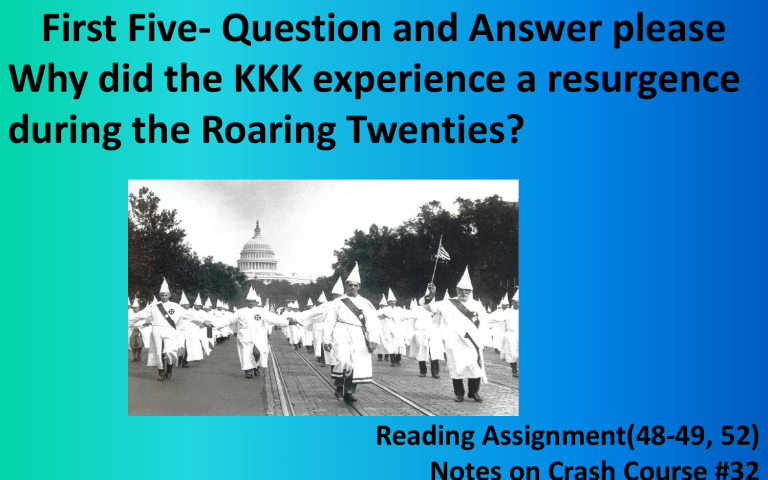
First Five- Question and Answer please Why did the KKK experience a resurgence during the Roaring Twenties? Reading Assignment(48-49, 52) The Roaring Twenties Learning Targets 7. I can describe “Flapper” culture and explain how women’s roles in society were changing. 8. I can describe the Lost Generation and the counterculture of the Roaring Twenties. 9. I can identify the major figures of the Harlem Renaissance, and explain its significance. 10.I can explain Prohibition and analyze its success or failure, including its impact on organized crime. 1. Flappers 1920s Cultural Changes A. Glorified personal freedoms, youth, entertainment B. Women becoming more independent, more educated, joining work force in greater numbers (though still in limited types of jobs), voting in 1920 C. “Flappers” – young women who demanded the same freedoms as men • • • New fashions – bobbed hair, short dresses, nylons, makeup New attitudes – smoked & drank in public, “The Charleston” Especially important for lower-middle class & working class Oxford Suit Jazz Suit Ties were a must—even when golfing. Argyle socks Oversized Baggy Pants for the Younger Man Raccoon Coat Clara Bow the “It Girl” (ultimate flapper) "Bernice Bobs Her Hair" Fitzgerald's fourth Saturday Evening Post story, May 1, 1920 Subject for cover illustration Flappers “Pick a Teammate” • • • • • Foursomes Chips face down on table Topic is FLAPPERS Take turns going around clockwise to draw a chip, read the prompt on the chip and compose a question Pick a teammate to answer the question Modernist Fundamentalist The MODERN Twenties reflected a clash of cultures between the old and new "Old" Culture "New" Culture Emphasized Production Emphasized Consumption Character Scarcity Religion Idealized the Past Local Culture Substance Personality Abundance Science Looked to the Future Mass Culture Image Modernists embrace Darwin’s Theory of Evolution Scopes “Monkey” Trial John Scopes Clarence Darrow Attorney for Scopes William Jennings Bryan addresses the court Attorney’s Making Small Talk Scopes Trial Broadcast on Radio 1920s Cultural Changes 3. Modernism vs. Fundamentalism A. Modernism adapted religion to modern society and modern science B. Fundamentalism preserved traditional Protestant beliefs • • C. Literal interpretation of the Bible with no room for error Rejected Darwin’s Theory of Evolution in favor of Creationism Scopes “Monkey” Trial • • • • • 1925 trial of John T. Scopes for teaching Evolution in Tennessee school (against 1925 law) ACLU hired Clarence Darrow to defend him William Jennings Bryan prosecuted Scopes found guilty, but did not settle the issue 1980s LA passed law requiring science teachers to teach Creationism, declared unconstitutional in 1997 Counter-Culture 4. Counter-Culture • • • • • • “The Lost Generation” Disillusioned with World War I and modern world, loss of American Dream and belief in progress Moved to Paris & lived “Bohemian” lifestyle – alcohol, drugs, loose living Earnest Hemmingway, William Faulkner, F. Scott Fitzgerald, Gertrude Stein Term came from Stein, popularized by Hemingway in The Sun also Rises Writings tended to be critical of modern society & materialism, individualistic, emotional, introspective The Lost Generation American literary notables who lived in Paris in 1920s and 1930s Ernest Hemingway Gertrude Stein William Faulkner F. Scott Fitzgerald Ernest Hemingway William Faulkner F. Scott Fitzgerald Gertrude Stein Video Notes: Jazz Age & Harlem Renaissance The Jazz Age 1. 2. 3. 4. 5. 6. Where did Jazz come from? (0:40) Who were its big names? (1:00) How did it become so popular? (1:15) How did it impact American culture? (2:00) Who was Marcus Garvey? (3:28) Why is Jazz significant? (3:57) The Harlem Renaissance 1. 2. 3. 4. 5. 6. 7. What is a “Renaissance?” (1:00) When did it take place? (1:15) What areas influenced it? (2:40) What were its three main themes? (3:00) Who were some of its major figures and what were their key works? (3:50) Why did it end? (6:15) Countee Cullen – “Color” (1925) Langston Hughes I, Too, Sing America Harlem Countee Cullen poet Zora Neale Hurston Their Eyes Were Watching God Mules and Men James Weldon Johnson Lift Every Voice and Sing songwriter poet journalist novelist Jazz is Born Back to Africa Movement 5. Prohibition Counter-Culture A. 18th Amendment (1920-1933) – illegal to make or sell alcohol in the U.S. B. Supporters thought Prohibition would reduce unemployment, domestic violence, poverty C. Volstead Act (1920) intended to enforce it • Impossible task, only 1500 federal agents D. Most people ignored the law • • E. Organized crime took over distribution and sale of liquor, became rich & powerful • • F. Bootleggers smuggled illegal alcohol Speakeasies (hidden saloons) opened everywhere Al Capone in Chicago Eventually jailed for tax evasion 21st Amendment repealed Prohibition in 1933 – had been “a noble experiment” Prohibition is difficult to enforce What does this cartoon tell you about Prohibition? HARDING HAS HOOCH AT WHITE HOUSE President Harding What’s that in your garter? Speakeasies pop up everywhere Bathtub Gin Blind Pig • Underground speakeasy Blind Tiger Bar that sold alcohol illegally during Prohibition Government agents disposing of illegal booze Bootleggers making more illegal booze
